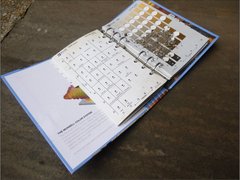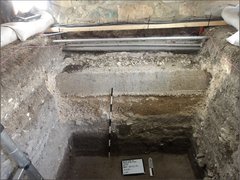Severe rain and thunderstorms throughout the week prevented any fieldwork for archaeologists, so instead time was spent in the lab processing artifacts. For this week, we would like to present some of the artifact types that archaeologists have encountered at the Long Barrack.
Long Barrack Archaeology Update - January 26
Goliad Ware by Evan Scherer, Ph.D.
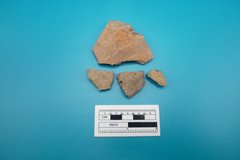
Goliad Ware is a type of pottery manufactured by the Indigenous communities in Central and South Texas, acquiring its name from the first archaeological site where it was identified, Mission Espíritu Santo de Zuñiga in Goliad Texas. . It is associated with historic Spanish Colonial sites throughout the region, though is most commonly found at missions. At sites without a historic component, Goliad Ware is called Leon Plain Ware. Goliad Ware is the predominant Indigenous ceramic type found at the San Antonio Missions. In the current excavations at the Alamo Long Barracks, Goliad was recovered from all excavation units.
Vessels were handmade from local clays and burned animal bone tempering, using the coil method and fired in an open bonfire setting. Due to the uneven firing temperatures common to this process, the color of vessels can range from gray, to dull orange, to dark and reddish-brown. The vessels could be plain or decorated with red or black pigment in linear designs, zigzags, or dots. The thickness of Goliad Ware can vary from 3-13mm, with bowls, jars and ollas being the most common forms.
This figure is an example of undecorated Goliad Plain Ware, the most common type of Goliad Ware found at the San Antonio Missions.
Biface by Anthony Herrera
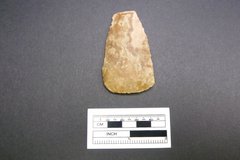
Archaeologists have recovered multiple lithics, or stone tools, from the Long Barrack excavation units. Stone tools were either multi- or single- purpose use and found throughout archaeological sites across Texas. Unlike debitage, bifaces are the primary focus of tool makers whereas debitage is the debris from the manufacturing process.
Pictured above is a late-stage biface recovered from EU-4 approximately 50cm below surface. Bifaces are tools that have two surfaces with flake scars on both sides, creating a sharp edge. The creation of a biface starts with a core of a chosen material, typically chert, and it is then worked into an initial shape by percussion or pressure flaking. As each stage progresses the core is reduced into a formalized tool.
Chinese Porcelain by Alec M. Reavis
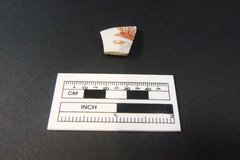
Chinese porcelain, a popular ceramic type among the Spanish colonists in Mexico, was encountered by archaeologists in every unit. The earliest shipment of the ceramic is likely traced to ships traveling from the Philippines to Mexico in the late 1500s. After the arrival of the Spanish in Texas, the earliest appearance of Chinese porcelain dates to the late 1600s. Chinese porcelain was often used for decorative purposes and special occasions, including religious ceremonies.
While they share similarities, Chinese porcelain is distinct from European porcelain. Chinese porcelain has a bluish-gray hue and is much thinner than European porcelain. There are two varieties of Chinese porcelain in Texas that date to the Ching Dynasty (1644-1912). The first slightly older porcelain variety displays either a blue underglaze or a gold and red underglaze. The second variety, which dates to the late 18th century, displays a red and gold overglaze.
Edged Ware by Lindsey Griffin
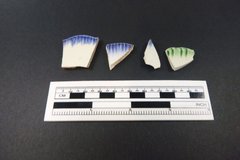
Edged Ware is a common ceramic type found within Historic sites across Texas. Although not as common as the locally produced Goliad and Spanish Colonial ceramics, edged European earthenwares were recovered in all the Long Barrack excavation units at varying depths. European earthenware tended to be more mass-produced, fired at higher temperatures, and exhibited lower porosity than Spanish Colonial ceramics.
Mass production and supply caused Edged Ware to be one of the most economical and commonly owned household ceramic types of the time. Edgware is characterized by a white paste and a green, blue, or red decorated and scalloped rim. Edged Wares typically have a thin lead glaze and are undecorated aside from the rim of the vessel. Vessel forms include plates and shallow bowls. Edged ware was produced in England from 1780-1850 and shipped to America in large quantities.
Digging In: Soil Profiles by Anna M. Schautteet
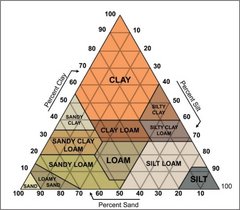
When most individuals think of archaeology, they often think of the artifacts that are produced from excavation. While each artifact does hold an important role in the story of the past, the sediments that surround each item assist in establishing the overall context of the archaeological deposit.
Archaeologists analyze and interpret each individual sediment type by creating what is called a soil profile. For the soil profile, each sediment type is identified as a separate “stratum” based on criteria such as: color, texture, and inclusions. Standardized color designation is achieved by utilizing a Munsell soil color chart (Figure 1). Texture is defined based on in-field assessments that allow archaeologists to roughly estimate percentages of sand, silt, and clay within each stratum. Based on these assessments, the archaeologists reference the Soil Texture Triangle (Figure 2) and designate a soil type. Lastly, the inclusions are items found within the sediment that are not associated with the texture. The inclusions range from common types (gravel, roots, and leaf-litter) to less common types (charcoal, calcium carbonate, or ferrous concretions).
Together these criteria form the descriptive signatures of each archaeological stratum. Along with the descriptions, the strata identified within a soil profile are also mapped, allowing the archaeologists to depict the shape and size of each stratum (Figure 3). Soil profiles allow archaeologists to interpret and identify both geological and cultural processes that are occurring at the archaeological site.
